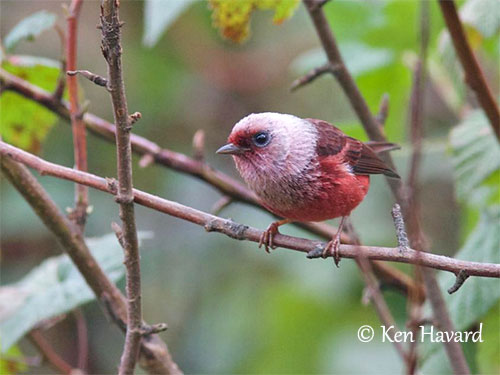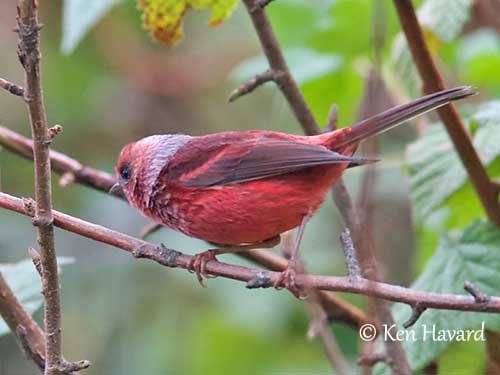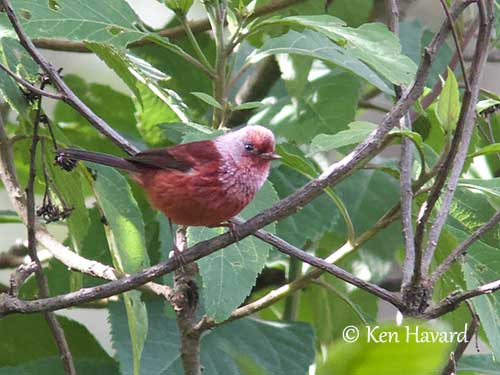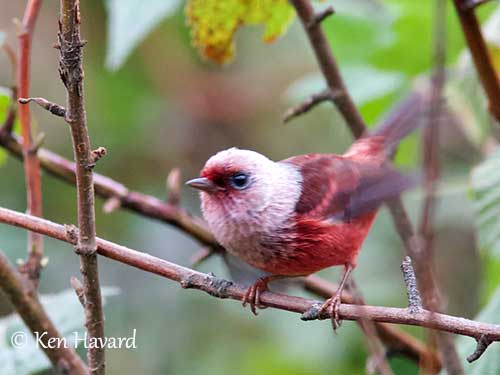
Fr: Paruline à tête rose
Ang: Pink-headed Warbler
All: Rosenwaldsänger
Esp: Reinita Rosada
Ita: Parula testarosa
Nd: Rozekopzanger
Sd: rosenskogssångare
Photographer:
Ken Havard
My Bird Gallery & Flickr gallery 1 & Flickr gallery 2
Text by Nicole Bouglouan
Sources:
HANDBOOK OF THE BIRDS OF THE WORLD Vol 15 by Josep del Hoyo-Andrew Elliot-David Christie - Lynx Edicions – ISBN: 9788496553682
A GUIDE TO THE BIRDS OF MEXICO AND NORTHERN CENTRAL AMERICA by Steve N. G. Howell, Sophie Webb - Oxford University Press - ISBN: 0198540124
New World Warblers par Jon Curson – Illustré par David Beadle, David Quinn - Editeur: Bloomsbury Publishing, 2010 – ISBN: 1408135167, 9781408135167
Wikipedia, the free encyclopaedia
Neotropical Birds – Cornell Lab of Ornithology
Pink-headed Warbler
Cardellina versicolor
Passeriformes Order – Parulidae Family
INTRODUCTION:
The Pink-headed Warbler is resident in the highlands of Guatemala and the Mexican state of Chiapas, where it occurs at least up to 2,000 metres of elevation. It frequents pine-oak and cypress forests with dense understorey. It feeds primarily on insects and is usually seen in pairs all year round. They nests in a dome-shaped structure placed near or on the ground.
The Pink-headed Warbler is threatened by fragmentation of forest throughout the range, and by intense human use of the remaining habitat. The species is suspected to be slowly declining and is classified as Vulnerable.

DESCRIPTION OF THE BIRD:
Biometrics:
Length: 13 cm
Weight: 10 g
The Pink-headed Warbler has maroon to deep carmine back and scapulars, whereas rump and uppertail-coverts are deep red. Uppertail and upperwing are dark brownish. The upperwing shows greater and median coverts with pink tips, forming two narrow pale wingbars. The upperpart feathers have greyish fringes in fresh plumage in autumn.
The underparts are deep red with sometimes pale pinkish margins to feather tips.
The head is pale silvery-pink. This colour extends down to throat and upperbreast, forming a conspicuous hood-pattern. The face is dark pink and the lores are variably dusky.
The plumage of head, neck and breast usually shows a satiny gloss, and the colours may vary with the light. The feather bases are dusky.
The bill is dark brown with pale horn lower mandible. The eyes are very dark. Legs and feet are pinkish-brown.
Male and female are similar, but the female may appear slightly duller.

The juvenile has maroon tinge on the upperparts, and appears cinnamon-brown overall. Wings and tail are brown. We can see tawny wingbars on greater and median coverts.
RANGE:
The Pink-headed Warbler is found in the highlands of Chiapas in SE Mexico, and in the highlands of Guatemala, E to Sierra de la Minas.
HABITAT:
The Pink-headed Warbler frequents pine-oak (Pinus-Quercus) and Cypress (Cupressus) forests with dense, undisturbed understorey and open canopy, between 2,000 and 3,800 metres of elevation, but mainly above 2,800 metres.
However, in Guatemala, it may frequent disturbed forest with damaged understorey. At forest edges, it can be seen in open brushy slopes.
CALLS AND SONGS: SOUNDS BY XENO-CANTO
The Pink-headed Warbler gives a thin, high-pitched and slightly buzzy “tseeip”.
The song is a varied series of high chips and short trills that often end with slightly emphatic notes.
BEHAVIOUR IN THE WILD:
The Pink-headed Warbler feeds primarily on insects and some fruits according to the season. Insects and various invertebrates are caught by gleaning in the dense understorey, between 2 and 5 metres above the ground, searching for prey on leaves and tree trunks.
But from an observation, the species was also seen foraging in the forest canopy, up to 15 metres above the ground in March/April. It may occasionally perform aerial sallies to catch flying insects.

They can be seen in pairs all year round, but during winter, they often join mixed-species flocks crossing their territory.
The Pink-headed Warbler has socially monogamous breeding system. The male maintains its territory all year round. It sings regularly in February, but from late March to mid-April, both male and female are less conspicuous.
The song of the male attracts females and a singing male is often seen surrounded by several females.
The Pink-headed Warbler is resident all year round. It is usually agile in flight.
REPRODUCTION OF THIS SPECIES:
The breeding season may occur between April and June, with the laying in April-May.
The Pink-headed Warbler builds a domed nest with side entrance near or on the ground, usually hidden in dense understorey. It is made with pine needles, and the cup is lined with moss.
The female lays 2-4 eggs and incubates during 11 days. The young fledge 10-11 days after hatching.
PROTECTION / THREATS / STATUS:
The Pink-headed Warbler is described a rare and local in Chiapas, whereas it is locally common in Guatemala. The numbers have severely reduced in recent years, due to habitat disturbance and destruction. Forest fragmentation, farming, timber extraction, flower production, animal-grazing, wood-cutting and road construction lead to increasing human disturbance.
The population is roughly placed in the band 20,000/49,999 individuals, but it is probably larger than previously estimated.
But currently, the Pink-headed Warbler is classified as Vulnerable.
